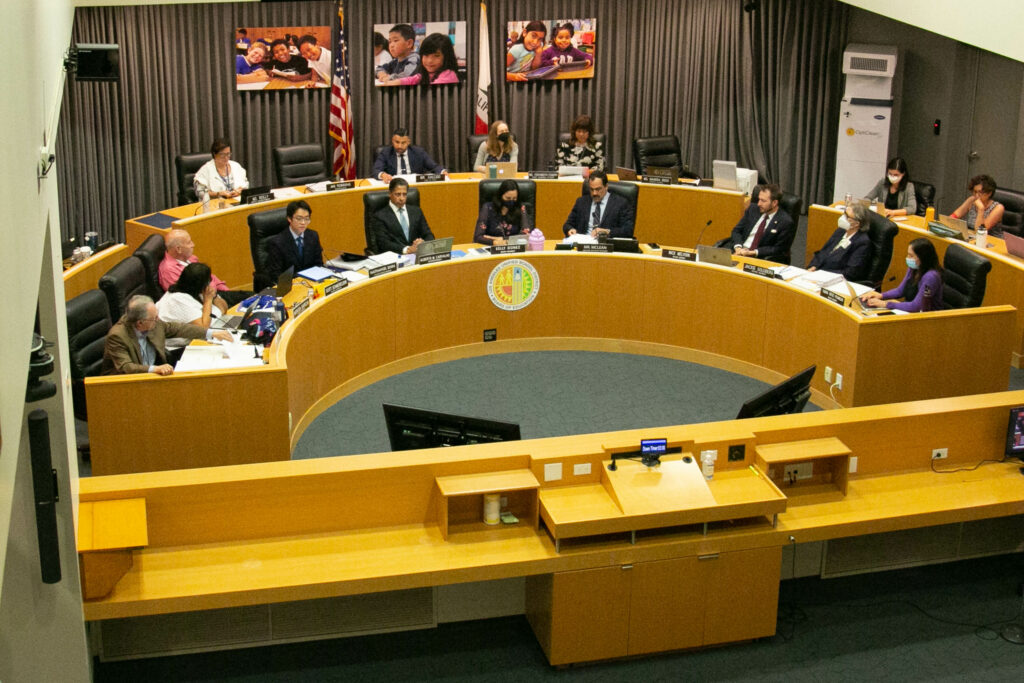
Credit: Allison Shelley/The Verbatim Agency for EDUimages
This is the first in a series of stories on how inadequate staffing may be impeding California’s efforts to offer high-quality instruction to all 4-year-olds by 2025.
Several California school districts and charter schools have been fined for violating state guidelines on average class size and/or staffing ratios in transitional kindergarten, a grade level that has been expanding to include all 4-year-olds by 2025.
Through its universal pre-kindergarten initiative, the state intends to offer high-quality instruction to all 4-year-olds through TK, an additional year of public education prior to kindergarten. To do so, California has implemented legislation placing requirements on transitional kindergarten and adding fiscal penalties for noncompliance. State-set TK guidelines require classes to maintain an average student enrollment of 24 kids and to use a 1:12 adult-to-student ratio.
Here are the highlights from audit reports from the 2022-23 school year, the first school year since the state added the fiscal penalties for TK requirements:
Ten school districts and 22 charter schools were not compliant with the required average class size of not more than 24 students, resulting in fines ranging from $1,706 to more than $6.9 million.
Seven school districts and 16 charter schools will pay between $2,813 and over $1.1 million for failure to meet the 1:12 adult-to-student ratio for TK classes.
Three school districts and 12 charter schools were out of compliance in both class size and adult-to-child ratio.
District audits review compliance with a sample of schools.
Based on the audit reports released to EdSource, the nationwide teacher shortage seems to be a leading reason for districts being out of compliance.
While most districts blame the national staffing shortage, some districts are critical of the California Department of Education for not clearly outlining TK requirements as well as for fining districts unfairly.
“It is not typical,” Los Angeles Unified Superintendent Alberto Carvalho said in late January when the district released its audit findings at a board meeting. “It does not make sense.”
The following districts and charters have been named as noncompliant, and fiscal penalties they face:
For going over the 24-student average enrollment
- Aspire Port City Academy, a charter and part of Aspire Public Schools: $20,146.42
- A charter school under Big Picture Educational Academy: $2,116
- Culver City Unified for two of its schools: $125,129
- Equitas Academy Charter School for its first and third Equitas Academy schools: $38,504.90
- Inglewood Unified for Bennett-Kew Elementary: $335,056
- John Adams Academy, the El Dorado Hills campus, which is a charter school: $21,156.60
- Seven charter schools in KIPP SoCal Public Schools – KIPP Iluminar Academy, KIPP Comienza Community Prep, KIPP Compton, KIPP Corazon Academy, KIPP Empower Academy, KIPP Ignite and KIPP Vida Preparatory Academy: $87,123.26, in all
- Los Angeles Unified for two district schools: $6,963,151.68
- Los Angeles Unified charter school, Hesby Oaks Leadership Center: $8,977.26
- Los Olivos Unified, a one-school district: $4,488.63
- Lowell Joint School District for Macy Elementary and Meadow Green Elementary: $81,051
- Monroe Elementary School District, a one-school district: $1,706
- A charter in Palm Springs Unified, Cielo Vista Charter School: $21,223
- Four charter schools run by Rocketship Education – Rocketship Delta Prep, Rocketship Alma Academy, Rocketship Mateo Sheedy Elementary and Rocketship Spark Academy: $91,688.13, in all
- Rowland Unified for Blandford Elementary: $217,351
- Scholarship Prep Charter School – Oceanside: $22,833.88
- Voices College-Bound Language Academies, charter school campuses in Morgan Hill, Mt. Pleasant and Stockton: $12,846.44
For not meeting 1:12 adult-student ratio
- Aromas-San Juan Unified for two of its schools: $154,715
- Culver City Unified for two of its schools: $61,886
- The same seven charters in KIPP SoCal Public Schools: $167,080.05
- Equitas Academy Charter School, Inc. for its first, third, fifth and sixth schools: $142,327.45
- A school in Laton Joint Unified, which only has one elementary: $30,943
- Los Angeles Unified for 20 district schools: $1,175,824
- Los Angeles Unified charters Canyon Charter Elementary and Knollwood Preparatory Academy: $30,943 and $61,886, respectively.
- Los Olivos Unified: $2,813
- Pomona Unified for Kingsley Elementary, San Jose Elementary, Armstrong Elementary and Philadelphia Elementary: $123,772 with each being penalized $30,943
- Two of the four charters fined for average enrollment under Rocketship Education, Rocketship Mateo Sheedy Elementary and Rocketship Spark Academy: $12,376.30, with both being penalized $6,188.15
- Sacramento City Unified for Hubert Bancroft Elementary: $53,261
- Scholarship Prep Charter School – Oceanside: $12,376.30
Not all the districts, such as Aromas-San Juan Unified, Culver City Unified and LAUSD, disclosed the names of the penalized schools in the audit reports. They are not required to do so.
The school districts and charters will lose funding from the Local Control Funding Formula in the amount of their penalties.
Unlike the other charter schools penalized, those in LAUSD and Palm Springs are operated by their respective school districts, rather than by charter management organizations. The fines received for the charter schools operated by LAUSD and Palm Springs Unified will be paid at the charter school level, not at the district level, according to the California Department of Education (CDE).
Why requirements on TK?
The state Education Department has outlined several benefits of implementing smaller TK class sizes and adult-to-student ratios.
According to the department’s September 2022 TK requirement presentation, more attention and feedback from adults creates more opportunities for student learning and engagement. With a smaller class size, teachers form better relationships with students, and parent participation improves.
The lower adult-to-student ratios, the CDE has said, allow staff to provide individualized instruction as well as supervision at all times. Additional adult support, the department says, leads to increased cognitive and social-emotional development, lower rates of students being placed in special education and teachers experiencing less stress. Plus, the 1:12 ratio is closely aligned with 1:8 staffing practices in early education at licensed child care centers, private preschools and state preschool programs and the 1:10 ratio at Head Start.
Noncompliance brings fiscal penalties
State compliance with TK requirements is verified in a district’s annual audit at the end of the school year. The TK class size requirement is based on the average number of students while the 1:12 staffing ratio is based on the number of district staff dedicated and available to all TK students in each class. The numbers are counted on the last teaching day of each school month before April 15. For most school districts, that is August to March.
How is the penalty determined?
Depending on whether the violation is for average student enrollment or the staffing ratio, penalty calculations consider areas such as base funding, the TK funding rate add-on, average daily attendance and the statewide absence rate.
For average student enrollment violations, the penalty equals the grade span base funding for TK/K-3 multiplied by the Second Principal Apportionment (P-2) for TK Average Daily Attendance (ADA).
For TK staffing ratio violations, the penalty equals the product of:
- Additional adults needed
- 24 reduced by the prior year elementary statewide absence rate
- TK add-on funding rate for the school year, which is available online; $2,813 was the funding rate for 2022-23
Some district audits miscalculated the class average or staffing ratio penalties, reducing the expected fines by hundreds of thousands of dollars for some.
Penalty amounts changed from $369,347 to $125,129 for the class average penalty in Culver City Unified; went from $641,561 to $217,351 for the class average penalty in Rowland Unified; changed from $239,133 to $81,051 for the class average penalty in Lowell Joint School District; and decreased from $10,483 to $2,813 for the staffing ratio penalty in Los Olivos School District.
A school district or charter school must maintain an average TK class enrollment of not more than 24 students for each campus. Because the audit considers the number of students each month, it is possible for a school to have a TK class that exceeds the limit for a time and still maintain an average of 24 or less.
For example, Marcella Gutierrez, a Mountain View School District TK teacher, told EdSource that she received her 25th student in February because her class enrollment average was under 24. Based on active enrollment at the end of each month, the number of students in her class was 24 in August and September, 23 in October when a student moved, 23 in November and December and 22 in early January when another student left the program but 24 by the end of the month when two new students joined her class.
With her class average at 23.5, not the 24-student classroom average for TK, the district accepted a 25th student for Gutierrez’s class. The district also added a third aide to meet the 1:12 student-staff ratio, she said.
According to the state Education Department, to be counted in the staffing ratio, the “assigned” adult must be an employee who is dedicated and available to all TK students the entire school day.
The audit selects a representative sample of schools to review compliance. If districts or charter schools are found to have violated the TK guidelines, they will face penalties for each sampled school in violation.
Schools blame staff shortage, CDE for shortfalls
School districts nationwide have struggled to hire paraprofessionals, such as aides, who work closely with teachers to support students in the classroom.
Legislation requires paraprofessionals to work alongside California teachers to lower class sizes and fulfill the 1:12 adult-to-student ratio requirement in TK classes.
According to the audit reports, districts and schools such as Scholarship Prep Charter School in Oceanside, Pomona Unified in eastern Los Angeles County and Culver City Unified, also in Los Angeles County, blame staffing shortages for their inability to comply with state guidelines.
But the staffing shortage isn’t limited to paraprofessionals. Based on state and regional hiring and vacancy data, state legislation has identified TK teachers as a high-need teaching position impacted by the teacher shortage.
Pomona Unified couldn’t maintain its staffing ratio at four schools that each needed the equivalent of 0.5 additional adults.
Culver City Unified was unable to hire enough teachers to stay within the class size enrollment or staffing ratio guidelines, resulting in noncompliance in two classes at two schools.
Even when staffing shortages played a role in noncompliance, some districts faulted the state Education Department.
The seven charter schools in KIPP SoCal Public Schools in Los Angeles that were penalized for being out of compliance for both class average and ratios said the state guidance about the TK program was not clear when their elementary schools planned their instruction and classroom models for the 2022-23 school year. Planning takes place before the school year starts.
Although July 2021 legislation introduced the TK requirements on average class size and staffing ratios, legislation in September 2022 added details to the requirements, at which time KIPP schools had already planned classroom instruction.
Historically, KIPP schools have created combination classes of TK and kindergarten students, with no more than five TK students in the class of 24, supervised by one teacher and an aide.
Because the students are educated in the same space, the TK adult-to-student ratio requirements must apply to all students in the combo class, according to the CDE. The class average has to be at or below 24 and the ratio at 1:12, even though only five TK students are in the class.
Similar to KIPP schools, Monroe Elementary School District in Fresno offered a combo class with TK and kindergarten students, resulting in an average enrollment of 29 kids.
The district acted under the incorrect assumption that the combo class would be considered two separate classes since the TK and kindergarten students had their own teachers. However, the class was considered one class and out of compliance.
KIPP schools have since implemented a monthly process to check student enrollment and ratios and will conduct more frequent audits.
Monroe Elementary School District also agreed to monitor enrollment numbers more closely; the school district will be annexed into Caruthers Unified by next school year.
One district publicly contests fines
Los Angeles Unified, California’s largest district, continues to struggle to fill vacant positions and achieve the required adult-to-student ratio.
District leaders called the penalties “egregious.” Los Angeles Unified incurred over $8.1 million in fines for being out of compliance with TK ratios and class size limits.
In the audit sampling of 88 schools, two exceeded the 24-student class size average and 20 did not maintain the 1:12 staffing ratio.
When the district’s audit results were released during a January LAUSD board meeting, district leaders, including Carvalho, said the district will work to ensure compliance but will push against schools incurring fines for lacking one additional adult.
The district received 20 fines, totaling $1,175,824, for not complying with the 1:12 ratio in its district schools, a fine they would have avoided if they had 19 additional adults in the TK classrooms.
“A small variance from the ratio brings about a significant fine,” Carvalho said, calling the penalties unfair and in need of fixing.
The district has already put mechanisms in place to track compliance this school year, including a TK toolkit for school and district administration, distributing specific revisions to TK legislation, and holding meetings with principals in the spring to review guidelines.
The school district will also host biweekly department meetings to monitor classes and have monthly meetings to identify schools that are not compliant with staffing ratios, according to its audit report.
Besides taking corrective action to address compliance with the transitional kindergarten requirement, penalized schools have two other options to respond to audit findings: an appeal or a payment plan. In March, the CDE issued letters to most of the penalized districts and charters asking them to choose what they plan to do.
Existing legislation does not allow districts to avoid penalties.
Under the appeals process, schools can challenge the finding based on “errors of fact or interpretation of law” including incorrect information in the audit findings or in the way the law is applied or interpreted.
They may also appeal on grounds that they were in substantial compliance with the law in which they can argue that, despite minor or unintentional noncompliance, they provided an educational benefit consistent with the purpose of the transitional kindergarten program.
According to CDE spokesperson Scott Roark via email, how soon the penalty is deducted from a district’s funding will depend on whether the school district or charter uses one of the options for resolving audit findings.








